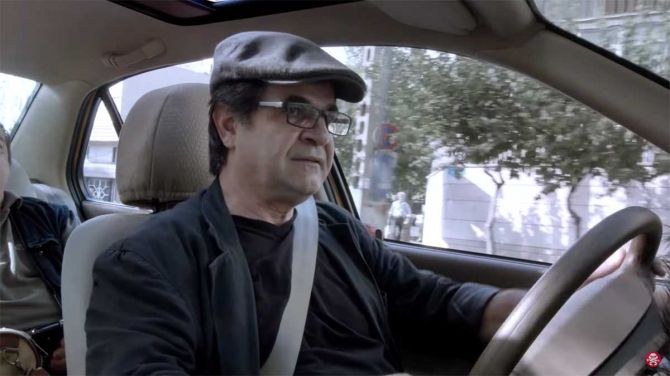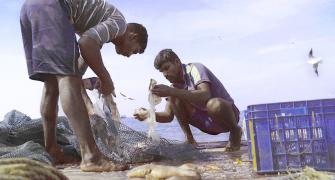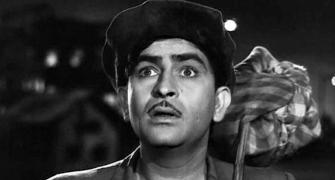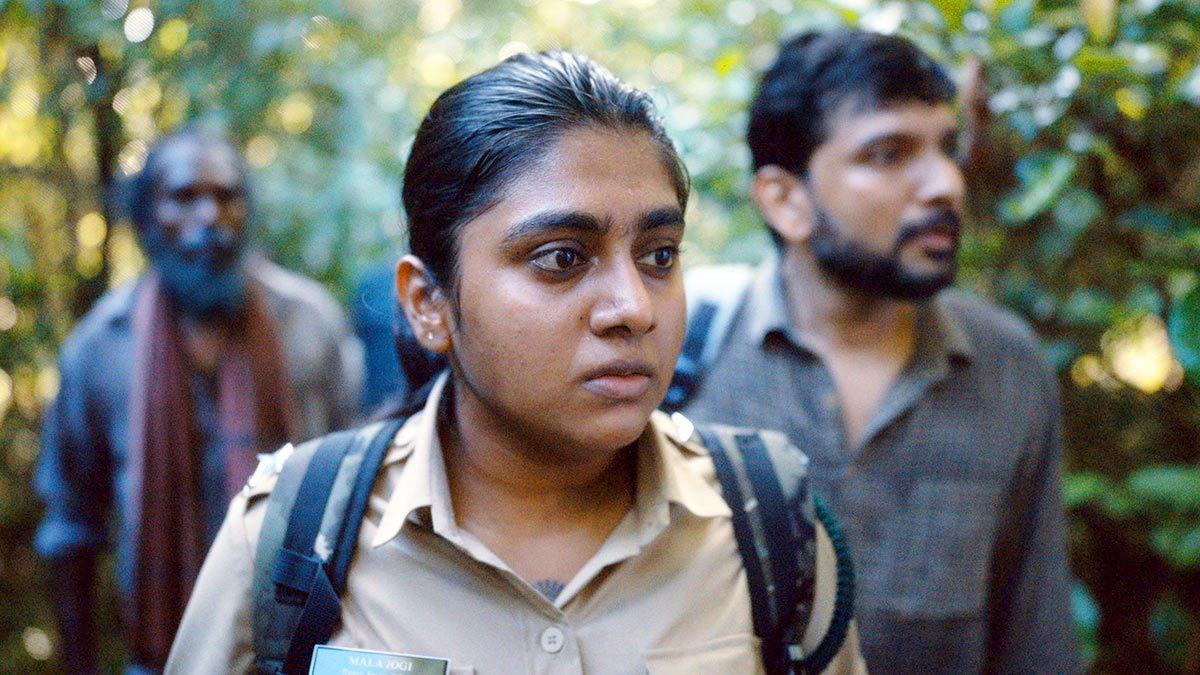'The Iranians are very resilient people. So even when they are throttled, they try their best to survive.'

Sreemoyee Singh's fascination with Iranian cinema started when she was a Masters student in film studies at Jadavpur University. She followed that up with a PhD on Exile Cinema in Post Revolution Iran.
Her focus was not just on Iranian film-makers living outside the country for political and artistic reasons.
As she says: "I also look at internal exile which is how I classify (Iranian film-maker) Jafar Panahi since his films are banned from being shown in Iran."
This year's Berlinale focused on two troubled areas of the world, Ukraine and Iran. One of the films shown was Singh's documentary And, Towards Happy Alleys, in which she talks to a group of Iranian film-makers. But the focus of the film remains Panahi.
Singh was fortunate enough to meet Panahi who has been jailed a few times for his political positions.
A free-flowing film where Singh also looks at her other experiences while visiting Iran And, Towards Happy Alleys is perhaps the first film by an Indian film-maker exploring the current state of the Asian country as it faces political and cultural challenges.
Rediff.com Senior Contributor Aseem Chhabra spoke to Sreemoyee Singh during the Berlin film festival, where she says, "Cinema initiated me to the (Iranian) society, gave me a lens to look at society... Obviously, I was affected by things that were happening. I couldn't look away and hence, it's all a part of my film."
Sreemoyee, when did you learn Farsi and become so fluent?
I went to Iran in 2015-2016 and studied two semesters of Farsi.
My spoken is much better because I didn't stop learning when the classes ended. I was living there, and was talking to everyone in Farsi.
There are so many shared words with Indian languages that it felt natural.
Also, the emotion was very deep because I watched many Iranian films, listened to Persian music.
The culture was very immersive.
From 2015 to 2019, I would visit Iran.

How did the idea of the film emerge?
I went to Iran because I was inspired by the Iranian new wave films of (Jafar) Panahi and (Abbas) Kiarostami. And because new wave cinema is taught with readings of the poetry of Forough (Farrokhzad).
Forough died at the age of 32.
She made a documentary called The House is Black (1963). It is considered to be one of the first new waves along with Brick And Mirror (1965).
Her poetry is considered to have sowed the seeds of the new wave because poetry is the most dominant form of expression in Iran.
Cinema, music and every other form of art is very deeply indebted to poetry.

You arrived there as a student but how did you reach somebody like Jafar Panahi? He comes across as a gentle, wonderful, man. I interviewed him in New York in 2001 for The Circle. He says in the film that he was not giving any interviews but was only doing it for your project.
I think I was taken seriously for two reasons.
One, because I made the effort to learn Farsi and I spoke fluently by the time I met Panahi.
The other reason was because I had a background in academics. I was doing my PhD and people knew that I was serious about this.
Was it easy to connect and find him?
No. It took me three months during my first stay.
I had planned to stay for one-and-a-half months, then I extended it because I hadn't heard from Panahi.
I knew I needed to make friends with people who are connected to journalism, reporting and news agencies.
At the end, at least five people had told Panahi, 'There's this girl from India. Meet her because she's learned Farsi. She's leaving soon.'
By the time Panahi wrote back to me I was almost ready to leave. When I heard from him, I had a Farsi exam the next day.
He wrote, 'Salaam. Welcome to Iran. Let's meet tomorrow.'
I told him, I had the exam next day, so he said 'Okay, the day after then.'

By which time he had been banned from film-making?
He was banned in 2009, with a 20 year ban on film-making. He was imprisoned for three months then.
He was never afraid because this is how the regime works.
They give you a sentence and put you in prison, then give you bail.
If you do something wrong again, you are put back in prison with the same sentence.
He was sentenced to six years of jail time. He is out on bail right now.

Some of the best moments in the film, of course, are your conversations with Panahi. But what gave me a great joy was that you were able to find those two actresses from Panahi's early films The White Balloon (1995) and The Mirror (1997). They were kids then, but have grown up to be beautiful young women.
However, this is something that I have not been able to understand. How has Panahi managed to make films like Closed Curtain (2013) and Taxi (2015)? There was a story that one of the films was copied on a flash drive and was smuggled to Berlin inside a cake.
I asked him and he said that's a story, a rumour and is not true.

But is that not considered making films especially when he made Taxi, where he drove around the city with a camera?
That is different. He is banned from officially making films, banned from working, being a part of the industry.
He cannot make films with actors and have a big crew.
He cannot be seen while making a film. That's how the government censors you, by putting limitations on you.
Every time he makes a film, it has to be self-funded. He cannot get outside funding.
That's why he ended up working on Taxi with his neighbours. His niece was in the taxi.
Mohammad Rasoulof (another imprisoned film-maker) once said that you are allowed to live in your country but your people don't know your work. You are erased from within the country.

Were you not able to interview Mohammad Rasoulof because he was imprisoned only recently?
I have written a chapter on him in my thesis but he was in prison when I went to Iran in 2015-2016.
He's been in and out of prison, even more than Panahi.
He and Panahi were both in prison together during the 2009 Green Movement protests.
Last year, when Rasoulof protested against a building that fell, he was arrested. And when Panahi went to visit him in prison, they arrested him too.

What about the other film-makers? There's Asghar Farhadi who has won two Oscars. Did you try to talk to him? And Mohsen Makhmalbaf?
Farhadi doesn't live in the country. He comes and goes, but he travels a lot.
Makhmalbaf lives in London. He is one of my mentors. He helped me considerably with this film.
He is a classic example of external exile. His entire family -- including his wife and his daughter Samira (director of Apple) -- now live in London.
The regime dropped a grenade on Samira's set, which was close to Afghanistan.
It was 2005 and Mohsen then took the decision to move out because it was getting very risky.

What is remarkable that there are other film-makers who are making movies and are quietly critical of the system. I saw this film called was Yalda, a Night of Forgiveness which dealt with the issue of blood money and Until Tomorrow about a single mother struggling to survive in Tehran.
There are films within the country, but deeply censored.
If you want to show a film within the country, you have to follow all the modesty codes and rules set by the government.
There's a circle of film-makers who are not in prison, but don't support the government.
They don't know how to make films anymore.

How are some film-makers able to circumvent censorship? Abbas Kiarostami made a number of films. Panahi made Offside in which a group of girls want to watch a football match.
This is because of the methods employed from Persian poetry.
The Iranian new wave was born as a form because the regime came to power in 1979 and nothing was allowed.
The early industry, which made commercial Farsi films, was erased.
The government wanted the new set of film-makers to make films keeping the rules in mind. But they discovered new ways; they employed children as mouthpieces to society.
They employed indirect metaphorical ways to talk about politics. For the longest time, the censor committees didn't catch it.
That's why poetry plays a huge role in any form of expression.
Kiarostami once said people are not literate, but communication happens through poetry. Poetry is in the veins of people.
While you were there, the anti-hijab protests started and it became important for you to include that into the film.
Cinema initiated me to the society, gave me a lens to look at society.
It's a regimented society, but I got access to women's spaces, their conversations, stories.
Obviously, I was affected by things that were happening. I couldn't look away and hence, it's all a part of my film.
The part on the scarf protests, that is connected to how freedom can be snatched away and how people have the power to get their freedom back.
The Iranians are very resilient people. So even when they are throttled, they try their best to survive.

In Taxi, there is a guy who gives pirated DVDs to Jafar Panahi and that's how he sees Woody Allen's films. I am sure there are pirated versions of his films available in Iran and some people do watch them.
That's a whole different industry in itself.
It's interesting because none of my Iranian friends had watched Taxi.
This was not in my film, but I was in the car with Aida Mohammadkhani (the child star from The White Balloon) when she asked me if I had watched Taxi.
I had my laptop and the film was saved on my hard drive.
There's a shot when I am copying Taxi for her, but we didn't use it in the final edit.
This is how it happens, how people in Iran can watch these films.
Feature Presentation: Ashish Narsale/Rediff.com









